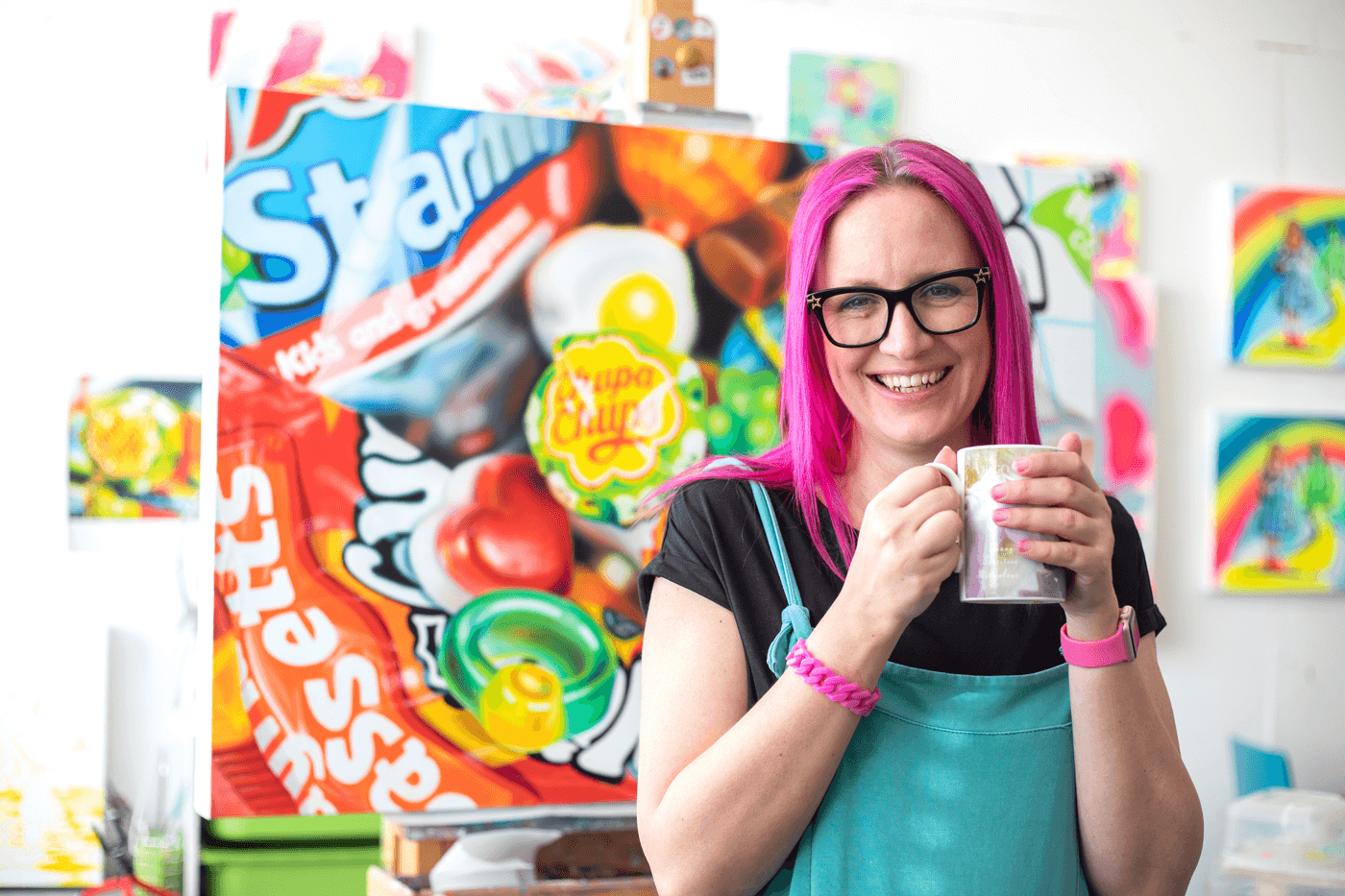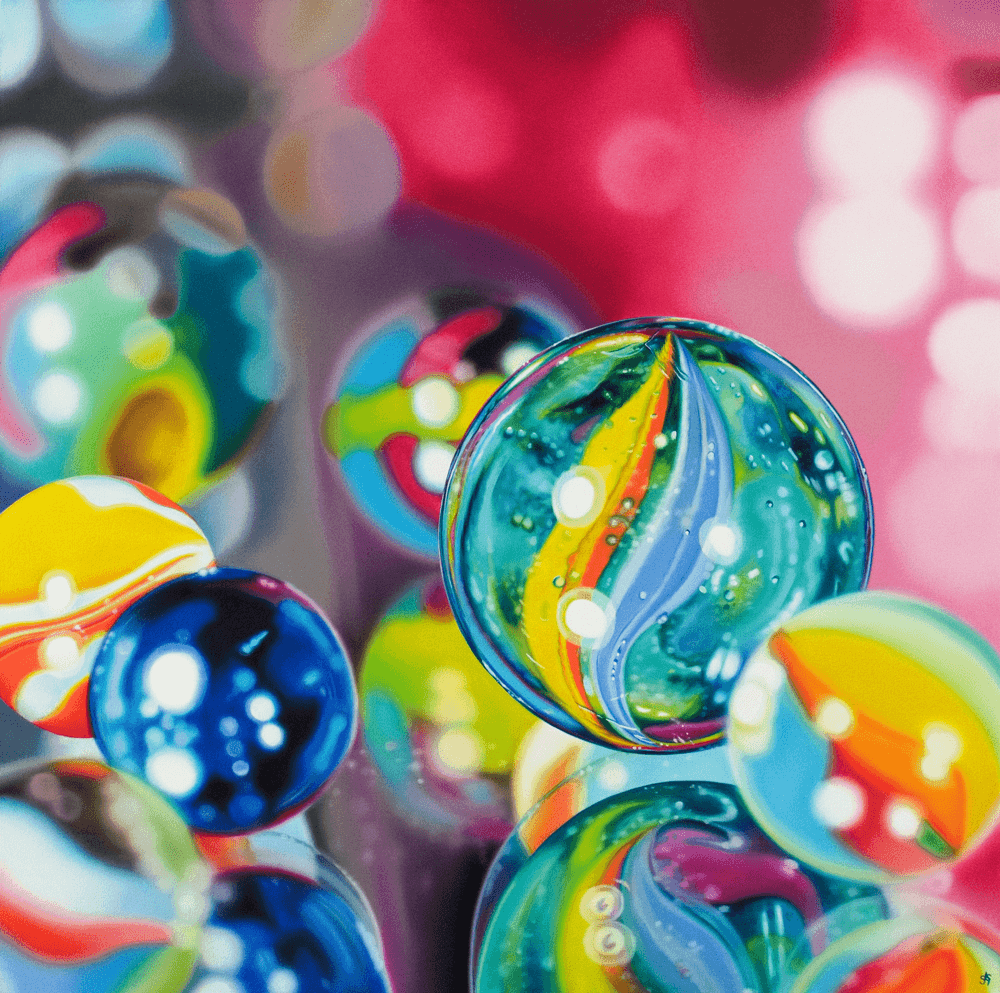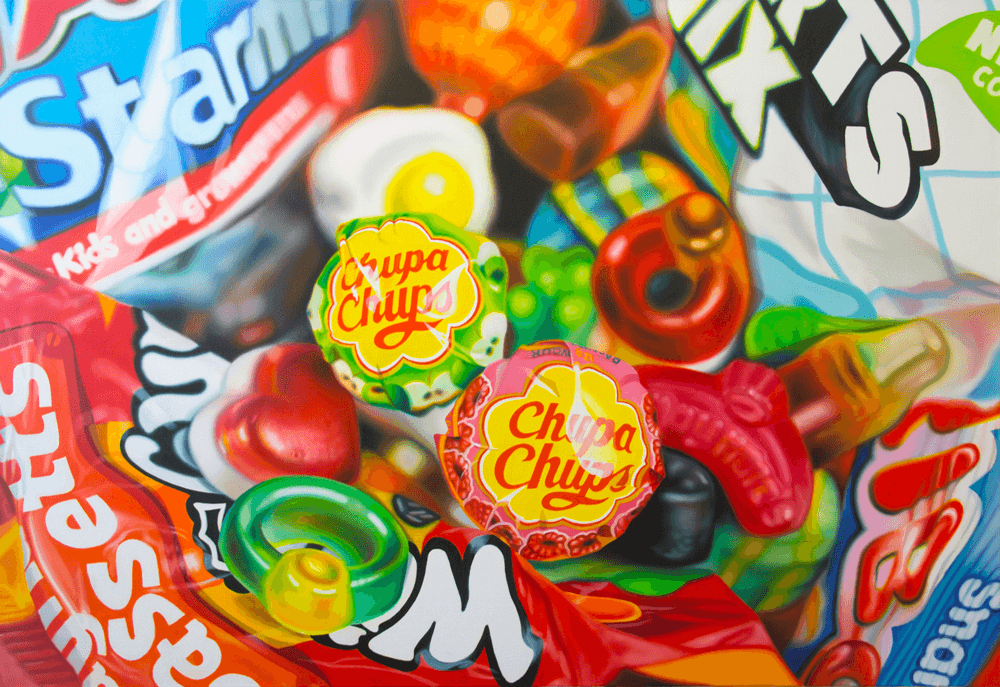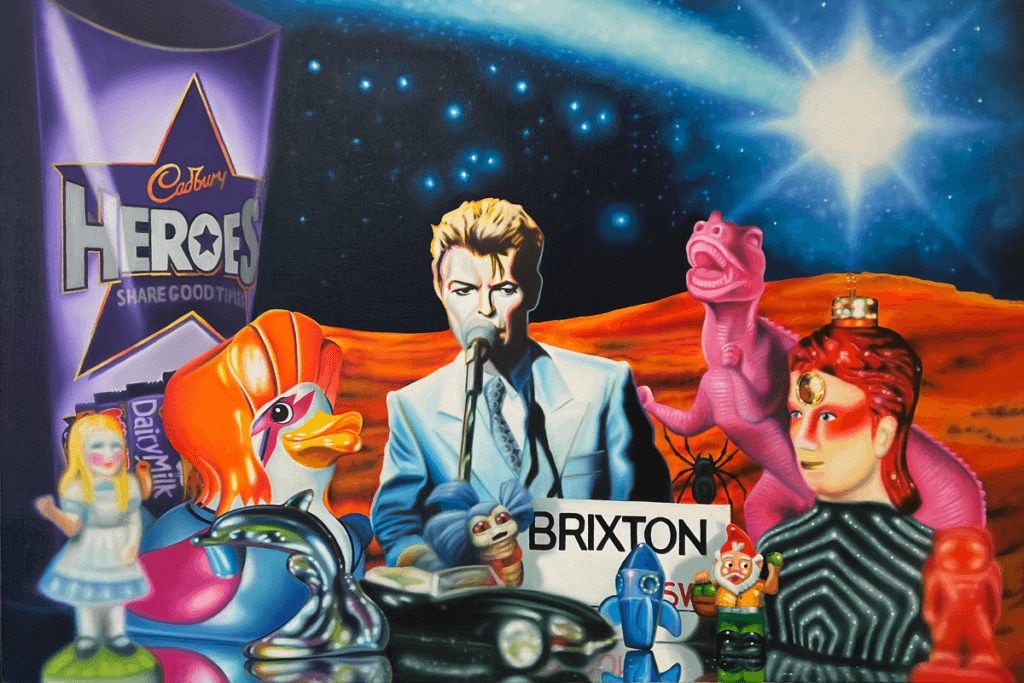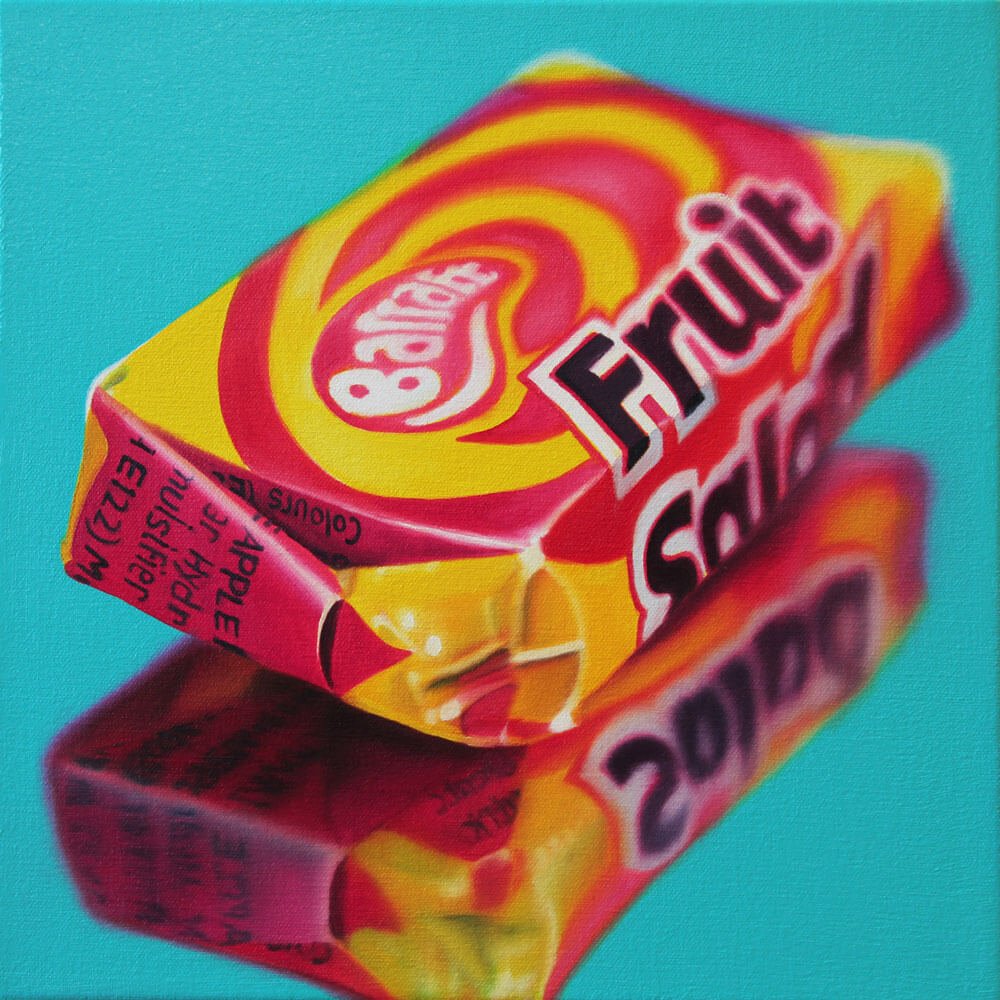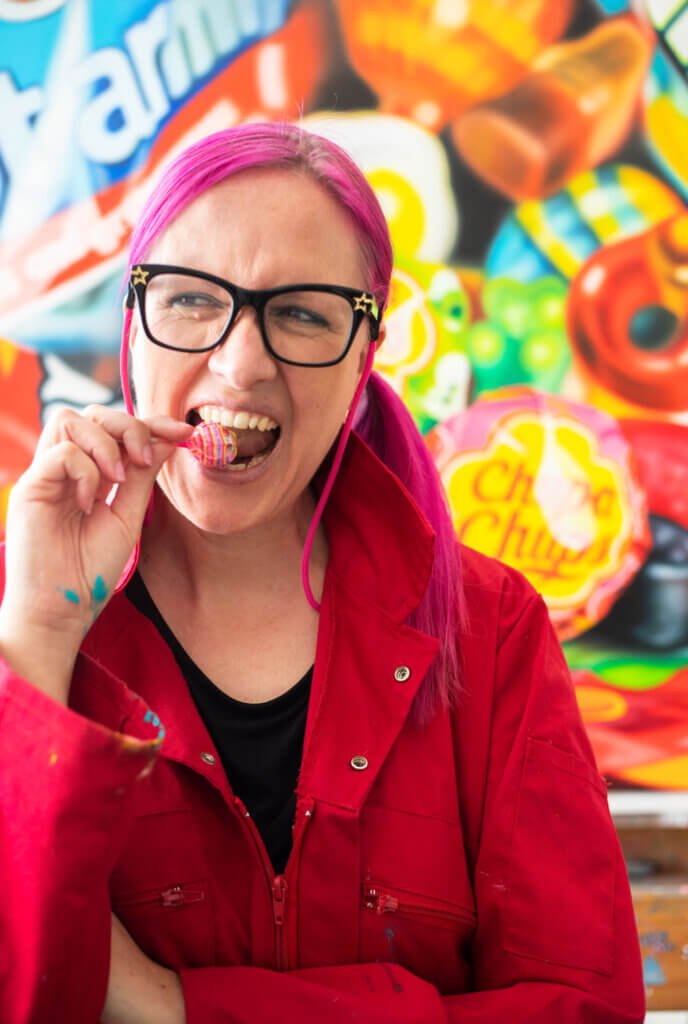Step into the enchanting world of British artist Sarah Graham, who expresses her love for all things nostalgic, beautifully captured in her photorealistic still-life paintings. Graham’s canvases featured an array of retro confectioneries, ranging from the iconic Chupa Chups lollipops and Haribo sweets to the beloved French Fancies and doughnuts accentuated with sprinkles, as well as classic toys from bygone eras, come alive with nostalgic bliss.
Through her meticulous technique and lavish application of colour, Graham propels us back to the sweetest moments of our youth, inviting us to see through the unspoiled lens of a child, rekindling our sense of wonder and delight. Graham’s sweet arrangements have caught the eyes of brands such as Harrods, Standard Chartered, Chupa Chups, and famous collectors like Roger Federer; Graham also created the cover for the Kaiser Chiefs album ‘Souvenir.’
Colour is at the heart of what I do, so I’m naturally drawn to subjects that allow me to satisfy that obsession
Sarah Graham
Her affinity with the sugary charms and vintage packaging stems from her job at the Pick n Mix station at her local Woolworths during her early years. This memory would later fuel her inspiration. Yet Graham’s artistic curiosity can be traced back to her father’s passion for photography and her interest in photorealism, particularly Gerhard Richter’s works.
However, the richness of Graham’s work extends beyond the sugary delights depicted in her paintings. Her work serves as a sign of resilience, hope and optimism, a beacon of light born from her own personal trials. For over 18 years, Graham grappled with mental health, including the turbulent journey through Bipolar Disorder, surviving two suicide attempts, and navigating severe mental health difficulties.
In the wake of these battles, she found herself without everything she had painstakingly built, including her formidable skill as a painter. For Graham, art was more than a profession. It became a life raft in turbulent waters, a therapeutic vessel to regain her balance.
Despite the shadows of her past, she has managed to rise from these dark chapters, attributing her resurgence to the restorative power of art; she says ‘art saved her life’, and it did precisely that. Now she is back with her biggest solo show to date, titled “Homecoming”, in her hometown of Hitchin at Arkley Fine Art in June. The show will feature over 25 original works on canvas alongside framed limited edition prints of Graham’s nostalgic aesthetic. We caught up with the Hitchin-based artist to learn about her practice, creative process, journey to recovery, and more.
Sarah! How are you doing? Thank you for taking the time to speak with us. Please introduce yourself to those who do not know you.
Sarah Graham: Thank you for having me! My name is Sarah Graham. I’m a photorealist oil painter based in Letchworth, Hertfordshire.
Please share a bit about your journey to becoming an artist. What were some of the critical moments or influences that led you to pursue this path?
Sarah Graham: Art was my strongest subject throughout school, but I didn’t think being an artist could be my job one day, especially as all the artists we studied were long dead! So, when it came to deciding what to do at University, I was very torn; most teachers said, ‘Keep art as a hobby’. To buy myself more time, I did an art foundation course, but while on it applied to study Psychology. At the end of the course the principal of the college visited me in my studio space to tell me I was making a huge mistake not pursuing my art. I knew he was right, so last minute, I switched to a Fine Art degree at De Montfort University in Leicester and have never looked back!
On graduating, I moved to Reading, and after a short stint working full-time in a shop, I discovered the Jelly Leg’d Chicken Arts Centre. The Jelly had a gorgeous purpose-built gallery in the town, and I walked in one day with one of my degree paintings, which they hung, and it sold straight away! I quit my shop job, and the gallery found me my first studio and offered me a part-time job.
They started taking my work to the Affordable Art Fair, so I set myself up as self-employed in 2001, and still am 22 years later! Another big break came in 2007, when I was signed by the Fine Art publishers, Washington Green. They produced prints of my originals, and suddenly my work was available in galleries across the UK. It was that that really established me. I left in 2014 and have been independent since then, producing my own prints, and doing the odd gallery show, but mostly working directly with clients.
Your practice delves into still life in hyper-realistic scenes that brim with vibrancy and frequently centre around confectionery items, toys, and iconic branding. Can you share what attracts you to these objects and how your childhood and nostalgia contribute to your artistic expression?
Sarah Graham: Colour is at the heart of what I do, so I’m naturally drawn to subjects that allow me to satisfy that obsession. I’m also a very positive person, nostalgia makes people happy, and I want people to see my art and smile. We live in a very demanding, hectic world, and if I can bring moments of stillness and joy into it, then what is better than that?
That incredible feeling you have as a kid walking into a toy shop, for example, that’s the sort of thing I’m trying to capture. When I was younger, I was always performing and playing the clown, I loved making people smile, and I think my art is an extension of that side of me. I was also head of ‘pick and mix’ in Woolworths in my teens, so who knows, perhaps that experience has informed my work at some deep subconscious level?!
Can you talk us through your creative process? How do you select a subject, and what does the process look like from the initial idea to the finished painting?
Sarah Graham: Ideas come from everywhere: eBay, vintage markets, my childhood, and sometimes just the deepest corners of my brain! Then it’s a case of attempting to recreate what is in my head into a photograph. I have a photography studio within my art studio, with powerful halogen lights, which I use to light a staging area where I create my still lives.
Once I settle on a photo, I do very little editing aside from cropping to the size of my canvas. From there, I scale up the image by eye, very occasionally using a grid if the image is very complex or has a lot of text.
I begin by sketching out in yellow acrylic paint so that mistakes can be easily rectified, followed by a full-colour acrylic underpainting, which acts as a guide for the main stage, the oil painting. By doing such a comprehensive underpainting, I can reference the source photo-less, allowing the painting space to evolve and take on an identity of its own. In that respect, I’m not slavishly copying a photo. I want to create something much more vivid than it is in the real world.
Your use of oil paints gives your work an incredible depth and luminosity. Could you explain how you developed your technique and why you chose to work with oil paints?
Sarah Graham: My dad bought me my first set of oil paints aged eight years old, so I’ve been using them for a long time! I guess the familiarity I have with them has helped me master them in a way. In terms of specific techniques, I learnt a lot from fellow students on my degree, particularly blending paint with large varnish brushes to get the blurred effect and using mediums to make the paint more malleable.
My technique was also heavily influenced by the photo paintings of Gerhard Richter; in fact, it was seeing his work in an art book during my degree that introduced me to photorealism. Again, thanks to my dad, I was into photography from a young age, so this was a style of working that allowed me to combine my love of photography and painting.
Could we delve into your personal life and your challenges with mental health? Being committed to a mental health institution during a manic phase and believing you are an MI5 agent unravelling terror schemes led to regular contact with the police. After leaving the mental health institution, you plunged into severe depression. Could you talk through what you were going through during this period?
Sarah Graham: My mental health struggles began in 2005, a year after my dad passed away. For ten years, my diagnosis was Major Depressive Disorder; however, in 2015, after rapidly switching mood states, I was diagnosed with Bipolar. Then in 2017, I had my first full-blown mania and, as you say, was eventually sectioned. A manic episode is literally the polar opposite of depression; you are euphoric, have tons of energy, don’t want to sleep, think you can achieve anything, and as you’ve said, I had delusions and even hallucinations.
The mania lasted several months, and the depression that followed it was almost a result of the fallout of what had happened to me. My marriage ended, and I had to sell my home and move into a rented one-bed flat. I had always had my husband to help me through my bipolar. Now I was on my own. I didn’t paint for the best part of 2 years and thought my career was finished, and I felt ashamed of all the things I’d done during the mania. As the depression began to eventually lift, I got back in the studio, which miraculously I still had thanks to the odd painting sale.
Once I was producing art again, I think it fast-tracked my recovery, it provided me with something positive to put my energy into and gave my life meaning. Although having not painted for so long, I had to virtually relearn how I paint. I’ll never forget finishing that first painting and the enormous sense of hope it gave me, especially as I’d been devoid of hope for so long. I did have the odd setback, but the trajectory was overall an upward one, and I’m now in remission and haven’t had an episode in 4 years.
Can we discuss your connection to David Bowie and his music during your walks? Amidst your psychosis, you believed you met Bowie while journeying on an asteroid through space, resulting in a deep personal connection. This encounter influenced the creation of ‘Starman’ in your ‘Wilderness of Kitsch series. Can you elaborate on this experience and how Bowie’s music supported you during a difficult time, fuelling your expression?
Sarah Graham: During my mania, I believed Bowie’s music protected me. I used it to shield me from the world; my paranoia was so extreme I thought people were trying to kill me. I remember one night, I thought I was going to get hit by a meteor, so I blasted his music super loud to create a force field around my house.
Once in the hospital, I had his music playing wherever I went, whether in my room or walking around and around the garden; as you say, I felt deeply connected to him. ‘Starman’ is my thank you to Bowie; it features him in front of a shooting star and the landscape of Mars, alongside references to his music in the shape of toys, figures, and chocolate. There’s even a laughing gnome in there! It was great to do such a personal piece. I love my still-life work, but creating more of a story through my work is something I plan to explore more.
Continuing, you mentioned that ‘Art saved your life‘ Could you elaborate on how your mental health journey has shaped your creative expression and how art has functioned as a healing medium in your recovery and daily life?
Sarah Graham: Fundamentally my art gives me a purpose, and not having children, it is the thing I have nurtured my entire life. During my years battling depression, it gave me something positive to focus on between episodes.
I am lucky to have had a career whereby I could lose months and go back to it, picking up where I left off. Of course, going long periods without working brought its own set of problems, mainly financial, but thanks to the self-belief my dad had instilled in me, I kept going and somehow survived!
I also see my work as the antidote to depression, and since recovering, my work has become even more colourful and joyful, if that’s even possible! Obviously, having this visual language to express myself has been therapeutic, too; any form of self-expression is deeply important for good mental health. Alongside a great deal of self-care, such as medication and exercise, I eat and sleep well, meditate and practise mindfulness & gratitude. I believe painting consistently is one of the main reasons why I’m now stable.
As someone deeply committed to supporting individuals facing mental health challenges, particularly Bipolar Disorder, you actively engage with schools and facilities to share your personal experience and promote the benefits of art therapy. Can you provide some insights into your work and the impact of your efforts?
Sarah Graham: I visit schools predominantly to provide art workshops, but during my initial talk, I always cover my mental health experiences to help normalise it. I’m trying to lead by example. If students see I’m not afraid to speak out, I hope it encourages them to do the same.
I also tell young people to talk to themselves like you would a best mate, rather than have that inner dialogue constantly berating yourself, essentially be kind to yourself. I’ve begun working with the Elysium Healthcare – Potters Bar Clinic School, where pupils are under a long-term section.
Just meeting someone who has been sectioned themselves but gone on to build a successful life has been hugely inspiring for them. I’m also a patron of the creative mental health charity PoetsIN, who do fantastic work in schools, providing workshops and special programmes to help young people. I believe the more people understand and share their experiences, the more mental health will be viewed in the same way we view physical health without shame.
In June, you will return to your hometown with your largest solo exhibition to date, “Homecoming,” showcasing more than 25 original works on canvas and framed limited editions. Could you share your feelings regarding this return to your roots, the exhibition’s significance, and what visitors can expect to experience?
Sarah Graham: The exhibition is going to be a celebration of how far I’ve come since I was sectioned in 2017. It means a lot that my biggest show ever is in my hometown, where I went to school, did my foundation course and lived for much of my adult life. I’ve become quite notorious in the town, but many won’t have seen my work in real life, apart from a 6-foot snowman I painted last Christmas as part of a sculpture trail! It will be a mix of some older work and mostly new pieces I’ve been working on, especially for the show, alongside prints and even a brand-new edition made up of sequins which I’m super excited about!! I hope people find it joyful and come away feeling uplifted and inspired by what they’ve seen.
What’s next for Sarah Graham?
Sarah Graham: To continue my mental health advocacy, speaking out where I can, to help break down stigma I’ve experienced my entire life. I’m also launching a very exciting fundraiser later this month to raise money for the Samaritans, who provided me with a vital lifeline during my severe depressive episodes, and who more than once saved my life.
This year I’m also part of a project called ‘Herts Shaped Box’ for 13–17-year-olds in Letchworth, providing an opportunity to produce an album, getting involved with everything from writing and playing music to production, sound engineering, and album art.
I’ll be running a workshop where they can recreate their favourite album covers and collaborate with them to create the cover for the finished album. Perhaps most importantly, I plan to keep painting for the rest of my life, which I think would be my greatest achievement. Although my mum once said to me, ‘When you going to be in that Tate?!’ so if I ever get there, it would be for her and my dad.
Lastly, what does art mean to you?
Sarah Graham: I can’t imagine my life without my art. It has been the one constant through all the ups and downs; ever since I could hold a pencil, it has been there for me. An outlet through which I can make myself, and others, feel uplifted.
©2023 Sarah Graham


